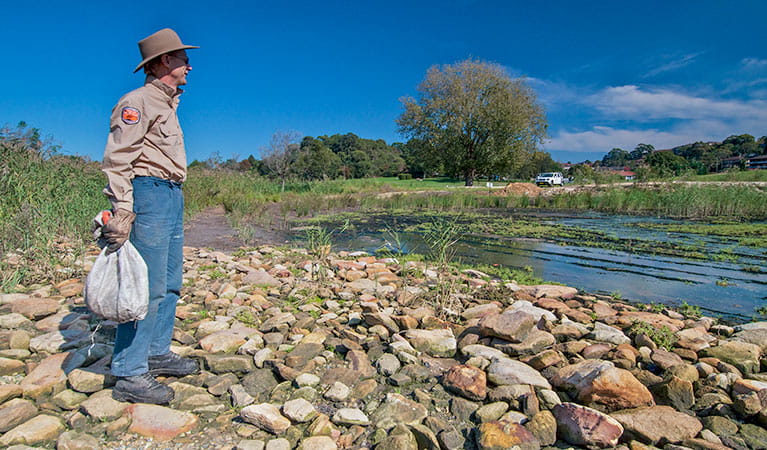Wolli Creek bush regeneration
Wolli Creek Regional Park
Overview
Volunteer with Wolli Creek Preservation Society to help protect the last area of substantial bushland in Sydney’s inner south-west.
- Work
- Bush regeneration, weed and pest management
- When
9am to 12.30pm, once a month on a Wednesday, Thursday, Friday, Saturday or Sunday. Includes a break for BYO morning tea and a catch up.
- Grade
- Medium
You’re invited to become part of this important bush regeneration work in Wolli Creek. There are a wide range of volunteering opportunities such as:
- Bird surveys
- Planting sessions
- Bush restoration
- Bat counts
- Stream watch
- Administration
- Campaigning
- Promotion
For the outdoor types, enjoy fresh air and exercise while working alongside like-minded individuals in the park’s bushland, heathland, parkland, wetland and saltmarshes.
When you volunteer with the Wolli Creek Preservation Society, you’re provided with training, guidance, information and tools. A map will be sent to you with meeting locations for bushcare, and you’ll also receive regular information on upcoming events such as talks, walks and the annual dinner. There’s great public transport access to Wolli Creek Regional Park.
Find out more about volunteering with us
Local alerts
For the latest updates on fires, closures and other alerts in this area, see https://www.nationalparks.nsw.gov.au/things-to-do/volunteer-activities/wolli-creek-bush-regeneration/local-alerts
Park info
- in Wolli Creek Regional Park in the Sydney and surrounds region
Wolli Creek Regional Park is always open but may have to close at times due to poor weather or fire danger
Visitor info
All the practical information you need to know about Wolli Creek bush regeneration.
Maps and downloads
Learn more
Wolli Creek bush regeneration is in Wolli Creek Regional Park. Here are just some of the reasons why this park is special:
Bird haven

Wolli Creek Regional Park is an important habitat for a variety of birds. Look for cormorants and darters as you're walking by the creek and keep an eye out for blue wrens and finches on the edge of the open lawns. In the sky you may catch a glimpse of brown goshawks and peregrine falcons on patrol.
- Wolli Creek walking track It’s such a treat to be able to take a bushwalk in the city. Look out for the amazing birdlife and enjoy the serenity of this short and easy walk.
Stretch your legs in the city

Just because you live in the city, it doesn’t mean you can’t enjoy the bush. Go for a run, take a leisurely stroll with the dog or let the kids burn off some energy on the trails and in the play areas. Wander the Wolli Creek walking track with its sandstone cliffs or walk the entire Two Valley trail. There are also several gorgeous spots around Wolli Creek Regional Park to meet family and friends for a barbecue or picnic. Relax on a rug while the kids play at the playground at Turrella Lawns or enjoy a quiet family picnic in the shade at Girrahween picnic area.
- Girrahween picnic area Enjoy a barbecue and laze under the trees at Girahween picnic area in Wolli Creek and leave the hustle and bustle of the city behind.
Plants and animals protected in this park
Animals
-

Grey-headed flying-fox (Pteropus poliocephalus)
The grey-headed flying fox is Australia's largest native bat, with a wingspan up to 1m. This threatened species travels up and down south-eastern Australia and plays a vital role in pollinating plants and spreading seeds in our native forests.

